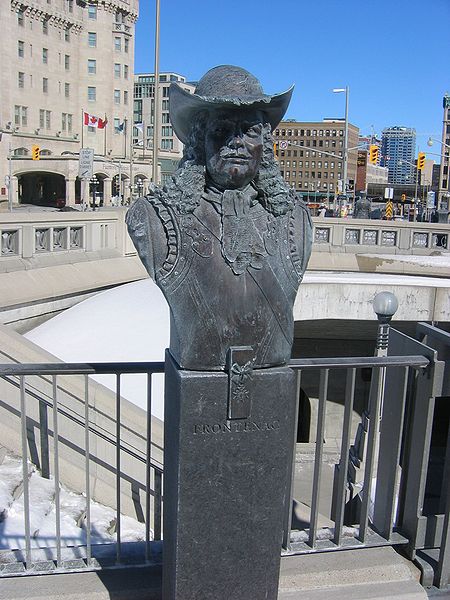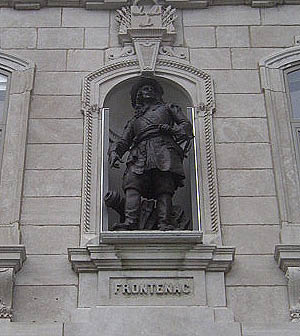<Back to Index>
- Mathematical Psychologist Anatol Rapoport, 1911
- Painter Mary Stevenson Cassatt, 1844
- Governor General of New France Louis de Buade, Comte de Frontenac et de Palluau, 1622
PAGE SPONSOR


Louis de Buade, Comte de Frontenac et de Palluau (May 22, 1622 – November 28, 1698) was a French soldier, courtier, and Governor General of New France from 1672 to 1682 and from 1689 to his death in 1698. He established a number of forts on the Great Lakes and engaged in a series of battles against the English and the Iroquois.
In his first term, he supported the expansion of the fur trade, establishing Fort Frontenac (in what is now Kingston, Ontario) and came into conflict with the other members of the Sovereign Council over its expansion and over the corvées required to build the new forts. In particular, despite the opposition of bishop François de Laval, he supported selling brandy to the First Nations, which Laval considered a mortal sin.
The conflict with the Sovereign Council led to his recall in 1682. His
second term was characterised by the defence of Quebec from a British
invasion during King William's War, a successful guerrilla campaign against the Iroquois and English settlements which resulted in the elimination of the Iroquois threat against New France, and a large expansion of the fur trade using Canadian coureurs des bois. He died before his second recall to France. Louis de Buade was born in Saint-Germain-en-Laye,
the son of Henri de Buade, colonel in the regiment of Navarre. The
details of his early life are meager, as no trace of the Frontenac
papers have been discovered. The de Buades, however, were a family of
distinction in the principality of Bearn. Antoine de Buade, seigneur de
Frontenac, grandfather of the future governor of Canada, attained
eminence as a councilor of state under Henri IV; and his children were
brought up with the dauphin, afterwards Louis XIII. Louis
de Buade entered the army at an early age. In the year 1635 he began
his military career and he served under the prince of Orange in
Holland, and fought with credit and received many wounds during
engagements in the Low Countries and in Italy. He was promoted to the
rank of colonel in the regiment of Normandy in 1643, and three years
later, after distinguishing himself at the siege of Orbitello, where he
had an arm broken, he was made marshal de camp. His service seems to
have been continuous until the conclusion of the Peace of Westphalia in
1648, when he returned to his father's house in Paris and married,
without the consent of her parents, Anne de la Grange-Trianon, a girl
of great beauty, who later became the friend and confidante of Madame
de Montpensier. The marriage was not a happy one, and after the birth
of a son incompatibility of temper led to a separation, the count
retiring to his estate on the Indre, where by an extravagant course of
living he became hopelessly involved in debt. Little is known of his
career for the next fifteen years beyond the fact that he held a high
position at court; but in the year 1669, when France sent a contingent
to assist the Venetians in the defense of Crete against the Turks,
Frontenac was placed in command of the troops on the recommendation of
Turenne. In this expedition he won military glory; but his fortune was
not improved thereby. A Seventeenth century painting of Anne de la
Grange-Trianon can be seen today at the Chateau de Versailles.
At
this period, the affairs of New France claimed the unexpected attention
of the French court. From the year 1665 the colony had been successfully administered by three remarkable men: Daniel de Rémy de Courcelle, the governor, Jean Talon, the intendant, and the Marquis de Tracy,
who had been appointed lieutenant general for the French king in
America; but a difference of opinion had arisen between the governor
and the intendant, and each had demanded the others recall in the
public interest. At this crisis in the administration of New France,
Frontenac was appointed to succeed de Courcelle. The
new governor arrived in Quebec on September 12, 1672. From the
beginning it was evident that he was prepared to give effect to a
policy of colonial expansion, and to exercise an independence of action
that did not coincide with the views of the monarch or of his minister Colbert.
One of the first acts of the governor, by which he sought to establish
in Canada the three estates — nobles, clergy and people — met with the
disapproval of the French court, and measures were adopted to curb his
ambition by increasing the power of the Sovereign Council and by reviving the office of intendant. Frontenac,
however, was a man of dominant spirit, jealous of authority, prepared
to exact obedience from all and to yield to none. In the course of
events he soon became involved in quarrels with the intendant touching
questions of precedence and with the ecclesiastics one or two of whom
ventured to criticize his proceedings. The church in New France had
been administered for many years by the religious orders; for the see
of Quebec, so long contemplated, had not yet been erected. But three
years after the arrival of Frontenac a former vicar apostolic, François-Xavier de Montmorency-Laval,
returned to Quebec as bishop, with a jurisdiction over the whole of New
France. In this redoubtable churchman the governor found a vigorous
opponent who was determined to render the state subordinate to the
church. Frontenac, following in this respect in the footsteps of his
predecessors, had issued trading licenses which permitted the sale of
intoxicants. The bishop, supported by the intendant, endeavored to
suppress this trade and sent an ambassador to France to obtain remedial
action. The views of the bishop were upheld and henceforth authority
was divided. Troubles ensued between the governor and the Sovereign Council, over its expansion and over the corvées required to build the new forts. In particular, despite the opposition of bishop François de Laval, he supported selling brandy to the First Nations, which Laval considered a mortal sin.
As the king and his minister had to listen to and adjudicate upon the
appeals from the contending parties their patience was at last worn
out, and both governor and intendant were recalled to France in the
year 1682. During
Frontenac's first administration many improvements had been made in the
country. The defenses had been strengthened, a fort was built at
Cataraqui (now Kingston, Ontario),
bearing the governors name, and conditions of peace had been fairly
maintained between the Iroquois on the one hand and the French and
their allies, the Ottawas and the Hurons, on the other. The progress of
events during the next few years proved that the recall of the governor
had been ill-timed. The Iroquois were assuming a threatening attitude
towards the inhabitants, and Frontenac's successor, La Barre, was quite
incapable of leading an army against such cunning foes. At the end of a
year La Barre was replaced by the marquis de Denonville, a man of
ability and courage, who, though he showed some vigor in marching
against the western Iroquois tribes, angered rather than intimidated
them, and the massacre of Lachine on August 5, 1689 must be regarded as one of the unhappy results of his administrations. The
affairs of the colony were now in a critical condition; a man of
experience and decision was needed to cope with the difficulties, and
Louis XIV, who was not wanting in sagacity, wisely made choice of the
choleric count to represent and uphold the power of France. When,
therefore, on October 15, 1689, Frontenac arrived in Quebec as governor
for the second time, he received an enthusiastic welcome, and
confidence was at once restored in the public mind. Quebec was not long to enjoy the blessing of peace. On October 16, 1690 several New England ships under the command of Sir William Phips, governor of Massachusetts,
appeared off the Island of Orleans, and an officer was sent ashore to
demand the surrender of the fort. Frontenac, bold and fearless,
responded with the famous words: "Non,
je n'ai point de réponse à faire à votre
général que par la bouche de mes canons et de mes fusils." ("I
have no reply to make to your general other than from the mouths of my
cannons and muskets."). Frontenac handled so vigorously the forces he
had collected as completely to repulse the enemy, who in their hasty retreat left behind a few pieces of artillery on the Beauport shore. The
prestige of the governor was greatly increased by this event, and he
was prepared to follow up his advantage by an attack on Boston from the
sea, but his resources were inadequate for the undertaking. New France
now rejoiced in a brief respite from her enemies, and during the
interval Frontenac encouraged the revival of the drama at the Chateau St-Louis and paid some attention to the social life of the colony. New
France had been under constant Iroquois attack during the 17th century.
The Iroquois, however, were not yet subdued, and for two years a petty
warfare was maintained. The sufferings of the colony, infested by
Iroquois war parties, were extreme. The fur trade, which formed its
only resource for subsistence, was completely cut off, and a great
accumulation of furs remained in the trading posts of the upper lakes,
prevented from descending by the watchful enemy. To meet the threat, he dispatched Jean Baptiste Bissot, Sieur de Vincennes, to establish a trading post and fort at Kekionga, present day Fort Wayne, Indiana. At
a grand council of the friendly tribes, Frontenac took up a hatchet,
brandished it in the air, and sang the war song, his officers following
his example. The Christian Indians of the neighboring missions rose and
joined them, and so also did the Hurons and the Algonquins of Lake
Nipissing, while Frontenac led the dance, whooping like the rest. His
allies, roused to martial frenzy, promised war to the death, and
several years of conflict followed. At length, after three years of
destitution and misery, Frontenac broke the blockade of the Ottawa; the
coveted treasure came safely to Montreal, and the colonists hailed him
as their father and deliverer. In
1696 Frontenac decided to take the field against the Iroquois, although
at this time he was seventy-six years of age. On July 6 he left Lachine
at the head of a considerable force for the village of the Onondagas,
where he arrived a month later. In the meantime the Iroquois had
abandoned their villages, and as pursuit was impracticable the army
commenced its return march on August 10. The old warrior endured the
fatigue of the march as well as the youngest soldier, and for his
courage and prowess he received the cross of St. Louis. Under
Frontenac's leadership, the Canadian militia became increasingly adept
at guerrilla warfare and took the war into Iroquois territory and
attacked a number of English settlements. The result was that the
Iroquois would never again be a peril to the colony. Frontenac
died on November 28, 1698 at the Chateau St-Louis after a brief
illness, deeply mourned by the Canadian people. The faults of the
governor were those of temperament, which had been fostered by early
environment. His nature was turbulent, and from his youth he had been
used to command; but underlying a rough exterior there was evidence of
a kindly heart. He was fearless, resourceful and decisive, and
triumphed as few men could have done over the difficulties and dangers
of a most critical position. At the time of his second appointment as Governor in 1689, France authorized the importation of slaves to Quebec from the West Indies. Quebec's most famous building and landmark, the Château Frontenac, is named after him, as is the Kingston Frontenacs ice hockey team.